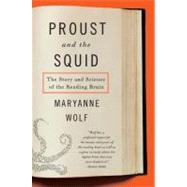Human beings were never born to read, writes Tufts University cognitive neuroscientist and child development expert Maryanne Wolf. Reading is a human invention that reflects how the brain rearranges itself to learn something new. In this ambitious, provocative book, Wolf chronicles the remarkable journey of the reading brain not only over the past five thousand years, since writing began, but also over the course of a single child's life, showing in the process why children with dyslexia have reading difficulties and singular gifts.
Lively, erudite, and rich with examples, Proust and the Squid asserts that the brain that examined the tiny clay tablets of the Sumerians was a very different brain from the one that is immersed in today's technology driven literacy. The potential transformations in this changed reading brain, Wolf argues, have profound implications for every child and for the intellectual development of our species.
“Fascinating Wolf restores our awe of the human brain.”-Associated Press
“Brilliant and eye opening.” -Albany Times Union
“Everything Wolf says makes sense She clearly knows her stuff.” -Washington Post Book World
“Wolf’s alarm about the spread of semi- literacy among the young is obviously justified, and her book provokes thought about it as only reading can.” -Sunday Times London
“Wolf’s conversational style, reflective comments and insights from work with children create a narrative flow and bright tone.” -Minneapolis Star Tribune
“Maryanne Wolf displays extraordinary passion and perceptiveness concerning the reading brain, its miraculous achievements and tragic dysfunctions.” -BookForum
“Intriguing” -New Scientist
“A book worth talking about.” -U.S. News & World Report
“Proust and the Squid is an inspiring celebration of the science of reading Wolf’s insights are fascinating Proust and the Squid has much to offer on this important perhaps the most important subject” -The Guardian London








